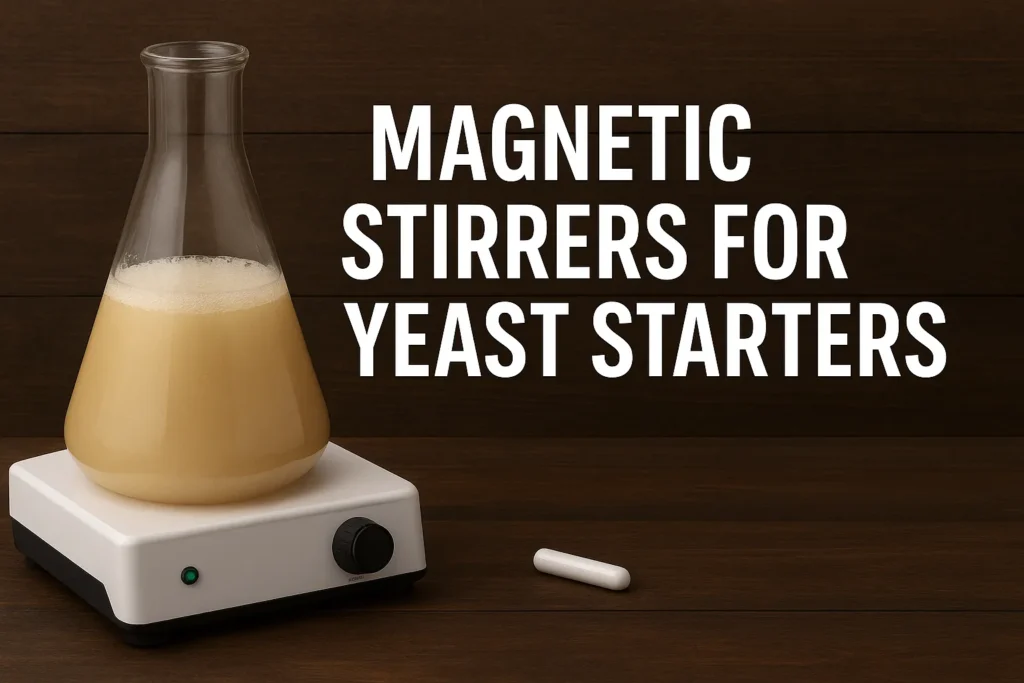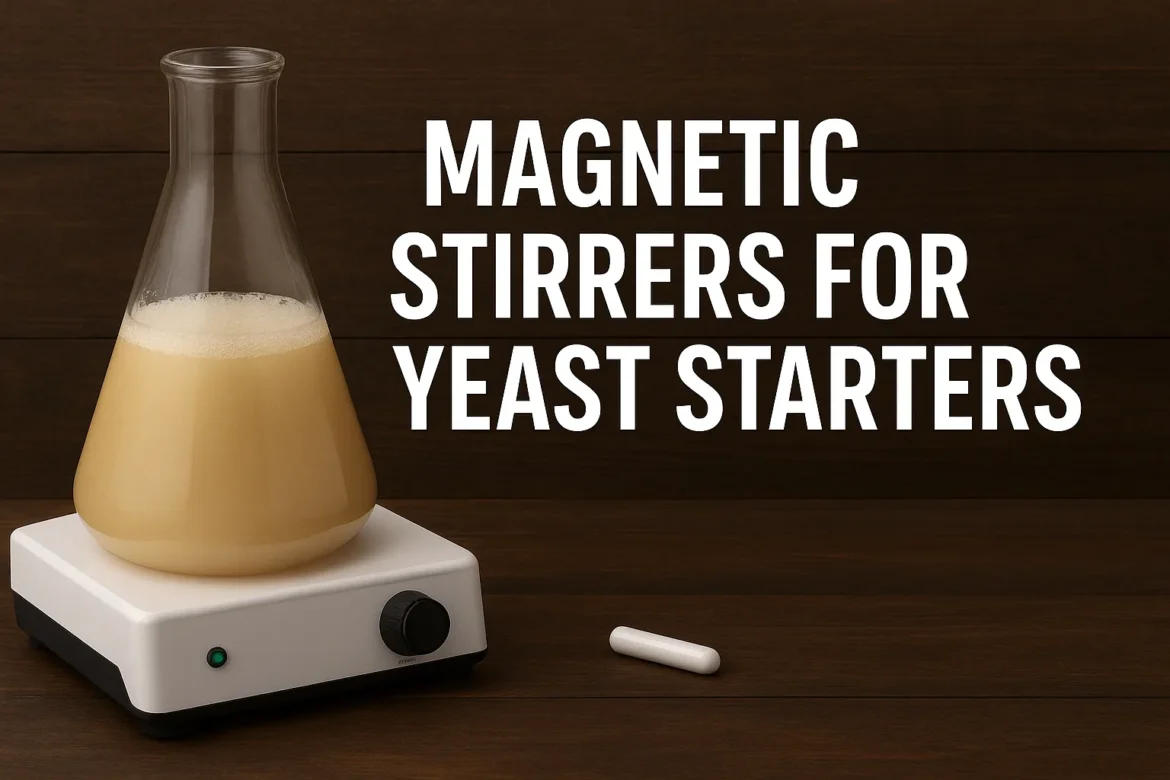Discover the best magnetic stirrers for yeast starters in homebrewing. Learn about benefits, top models, DIY options, and how magnetic stirrers dramatically improve yeast propagation, reduce fermentation time, and enhance beer quality through continuous aeration.

Yeast health represents the foundation of exceptional brewing, yet many homebrewers underestimate the transformative power of proper yeast propagation. After years of brewing with traditional shaken starters and eventually discovering magnetic stirrers, I can confidently state that few equipment investments deliver such dramatic improvements in fermentation performance, beer quality, and brewing consistency.
My early brewing experiences involved laboriously shaking yeast starter flasks every few hours, watching fermentation times stretch endlessly while battling off-flavors and stuck fermentations. The revelation came when I invested in my first magnetic stirrer—what had been a tedious, inconsistent process became an automated, reliable system that consistently delivered healthier yeast populations and cleaner fermentations.
This comprehensive guide explores every aspect of magnetic stirrers for yeast starters, from understanding the science behind continuous agitation to selecting optimal equipment and maximizing yeast propagation efficiency. The insights presented here reflect extensive practical experience, systematic testing, and collaboration with fellow brewers who’ve witnessed similar transformations in their brewing quality.
Whether you’re struggling with sluggish fermentations, seeking to optimize yeast management, or simply curious about this powerful brewing tool, understanding magnetic stirrer technology opens doors to more consistent, higher-quality brewing results that will elevate every batch you produce.
Understanding Yeast Propagation Science and Magnetic Stirring Benefits
Effective yeast propagation requires optimal conditions including adequate nutrition, appropriate temperature, proper aeration, and continuous agitation to maximize cell multiplication rates. Magnetic stirrers address the critical agitation component that dramatically influences propagation success.
Cellular Respiration and Oxygen Requirements
Yeast cells undergo aerobic respiration during propagation phases, consuming oxygen to fuel cellular reproduction and sterol synthesis essential for healthy cell membranes. Continuous stirring maintains dissolved oxygen levels while preventing carbon dioxide accumulation that inhibits further growth.
Surface Area Maximization Through Agitation
Static starter cultures develop stratified layers with limited gas exchange and nutrient distribution. Magnetic stirring creates constant fluid motion that maximizes liquid-air interface area while ensuring uniform nutrient distribution throughout the starter volume.
Growth Phase Optimization and Cell Count Multiplication
Studies demonstrate that stirred starters achieve 5-10 times higher cell counts compared to static cultures through improved oxygenation and waste product removal. This multiplication effect reduces required starter volumes while delivering healthier yeast populations.
Temperature Management and Heat Distribution
Continuous agitation prevents thermal stratification while distributing metabolic heat evenly throughout starter volumes. This temperature uniformity ensures consistent growth conditions that optimize reproduction rates and cellular health.
Carbon Dioxide Removal and pH Stability
Fermentation produces carbon dioxide that dissolves in starter wort, creating acidic conditions that inhibit further yeast growth. Stirring action strips dissolved CO2 from solution while maintaining pH levels conducive to continued propagation.
Magnetic Stirrers for Yeast Starters Types of Magnetic Stirrers and Their Applications
Different magnetic stirrer designs offer varying capabilities, features, and price points that serve different brewing requirements and operational preferences. Understanding these options guides optimal selection for specific yeast management needs.
Basic Laboratory Stirrers
Entry-level magnetic stirrers provide essential functionality including variable speed control and magnetic coupling sufficient for standard yeast starter applications. These units typically handle 1-2 liter starter volumes with adequate stirring power for most homebrewing requirements.
Advanced Multi-Function Stirrers
Professional stirrers incorporate heating elements, temperature controllers, timers, and enhanced magnetic strength that support larger starter volumes and more precise process control. These features benefit serious brewers managing multiple yeast strains or complex propagation schedules.
Brewing-Specific Stir Plates
Specialized brewing stirrers optimize design elements for yeast starter applications including appropriate speed ranges, enhanced magnetic coupling, and features like programmable timers that align with typical propagation schedules.
DIY and Custom Solutions
Creative brewers construct magnetic stirrers using computer fans, magnets, and basic electronics, achieving functional performance at budget-friendly costs while gaining deeper understanding of stirrer operation principles.
| Stirrer Type | Capacity Range | Speed Control | Heating Capability | Price Range | Best Application |
|---|---|---|---|---|---|
| Basic Lab Model | 0.5-2L | Variable | No | $25-75 | Standard starters |
| Advanced Lab | 1-5L | Digital | Yes | $100-300 | Multiple strains |
| Brewing Specific | 1-4L | Programmable | Optional | $80-200 | Dedicated brewing |
| DIY Build | Variable | Basic | No | $15-40 | Budget solution |
Top Magnetic Stirrer Recommendations and Reviews
Based on extensive testing and practical brewing experience, several magnetic stirrers consistently deliver exceptional performance for yeast starter applications across different price points and feature requirements.
Northern Brewer Maelstrom Stir Plate
This programmable stirrer accommodates starters up to 5 gallons with five distinct speed settings and 48-hour timer functionality. The powerful magnetic coupling ensures consistent stirring without bar ejection, while the programmable features enable hands-off operation aligned with brewing schedules.
Performance testing demonstrates reliable operation across different starter viscosities and volumes, with magnetic strength sufficient for deep vortex formation even in large flasks. The build quality justifies the premium pricing through consistent performance and long-term reliability.
Apera Instruments AI2801 Magnetic Stir Plate
This compact stirrer balances performance and affordability, handling up to 2-liter starters with 2300 RPM maximum speed and two-year warranty protection. The lightweight design and rubber feet ensure stable, quiet operation while included stir bars accommodate various starter sizes.
The straightforward operation appeals to brewers seeking reliable functionality without complex programming features. While limited to smaller starter volumes, the performance and value proposition make it excellent for standard homebrewing applications.
JoanLab MS5 Professional Stirrer
Designed for laboratory applications, this stirrer provides precise speed control and consistent performance suitable for demanding brewing requirements. The robust construction and professional features justify consideration for serious yeast management programs.
The enhanced magnetic strength and variable speed control accommodate diverse starter requirements while maintaining laboratory-grade reliability standards that ensure consistent performance over extended operational periods.
MoreBeer! Magnetic Stir Plate
This mid-range stirrer features built-in support arms and 5-liter capacity handling for larger starter volumes. The precision speed controls and stable platform design provide reliable performance, though some users report longevity concerns after extended use periods.
The capacity advantage makes this stirrer attractive for high-gravity brewing or multiple strain propagation, while the support arm functionality adds convenience for temperature monitoring during propagation cycles.
DIY Magnetic Stirrer Construction and Customization
Building custom magnetic stirrers provides cost-effective solutions while offering learning opportunities about stirrer operation principles and customization possibilities that commercial units may not provide.
Essential Components and Materials
DIY stirrer construction requires computer fans, neodymium magnets, electronic speed controllers, and enclosure materials. Quality component selection determines performance reliability and operational longevity while keeping costs reasonable.
Motor Selection and Speed Control
Computer fans provide reliable, quiet operation with built-in speed control capabilities. 12V DC fans offer sufficient torque for yeast starter applications while consuming minimal power and generating minimal heat during extended operation periods.
Magnetic Coupling Design and Optimization
Proper magnet placement and strength determine stirring effectiveness and maximum capacity handling. Multiple smaller magnets often outperform single large magnets through improved magnetic field distribution and reduced hot spots that can cause stir bar ejection.
Enclosure Design and Safety Considerations
Professional-looking enclosures protect electronics while providing stable platforms for starter vessels. Safety considerations include proper electrical isolation, adequate ventilation, and spillage protection that prevents damage from accidental liquid contact.
Performance Optimization and Troubleshooting
DIY stirrers benefit from systematic testing and adjustment to optimize performance across different starter volumes and viscosities. Understanding performance limitations guides realistic expectations and appropriate application selection.
For comprehensive yeast starter techniques and advanced propagation strategies, explore the detailed resources at BrewMyBeer’s yeast management guides, where professional yeast handling meets practical homebrewing applications.
Optimal Operating Techniques and Best Practices
Maximizing magnetic stirrer effectiveness requires understanding proper operation techniques, starter preparation methods, and environmental considerations that influence yeast propagation success and equipment longevity.
Starter Preparation and Wort Composition
Optimal starter wort maintains 1.030-1.040 specific gravity using light dried malt extract, providing adequate nutrition without excessive sugar concentrations that stress yeast cells. Proper boiling and cooling procedures ensure sterile conditions essential for contamination-free propagation.
Stir Bar Selection and Sizing
Appropriate stir bar selection influences mixing effectiveness and vortex formation quality. Longer bars provide better mixing in large volumes but require stronger magnetic coupling, while smaller bars work effectively in compact vessels with limited clearance.
Speed Optimization and Vortex Formation
Optimal stirring speed creates consistent vortex formation that reaches the flask bottom without causing excessive foam formation or stir bar ejection. Starting slowly and gradually increasing speed prevents stir bar loss while achieving maximum aeration effectiveness.
Temperature Management and Environmental Control
Room temperature propagation typically provides optimal results, though some yeast strains benefit from slightly elevated temperatures. Continuous stirring generates modest heat through friction, contributing to optimal growth conditions without requiring external heating.
Timing and Propagation Schedules
Typical propagation cycles require 18-24 hours for adequate cell multiplication, though high-gravity applications may benefit from extended periods or step-up procedures. Monitoring visual activity guides optimal harvest timing for maximum viability.
Safety Considerations and Equipment Maintenance
Proper safety protocols and systematic maintenance ensure reliable stirrer operation while preventing equipment damage and maintaining sterile conditions essential for successful yeast propagation.
Electrical Safety and Spillage Protection
Magnetic stirrers combine electrical equipment with liquid handling, creating potential safety hazards that require systematic precautions. Proper grounding, spillage barriers, and electrical isolation prevent dangerous conditions while protecting equipment from damage.
Sterilization and Contamination Prevention
Stir bars require thorough sterilization before each use through boiling, chemical sanitization, or flame sterilization techniques. Proper handling and storage prevent contamination introduction that can ruin entire propagation cycles.
Magnetic Coupling Maintenance and Calibration
Magnetic strength can diminish over time through exposure to heat, impacts, or electrical interference. Periodic testing ensures adequate coupling strength while identifying components requiring replacement or adjustment.
Component Inspection and Replacement
Regular inspection identifies wear patterns, corrosion, or damage before they cause operational failures. Stir bars are consumable components requiring periodic replacement, while electronic components may require service or replacement over extended operational periods.
Cleaning Protocols and Storage Procedures
Systematic cleaning procedures remove starter residues while preventing contamination buildup that can affect future propagation cycles. Proper storage protects equipment from environmental damage while maintaining readiness for brewing operations.
Advanced Techniques and Multi-Stage Propagation
Sophisticated yeast management programs utilize advanced techniques including step-up propagation, strain isolation, and specialized equipment that maximize yeast health while supporting complex brewing requirements.
Step-Up Propagation Strategies
Large starter requirements benefit from step-up procedures that gradually increase starter volumes through multiple propagation stages. This approach maintains optimal cell density while preventing nutritional depletion that limits growth in oversized single-stage starters.
Multiple Strain Management
Advanced brewers maintaining multiple yeast strains benefit from systematic propagation schedules and dedicated equipment that prevents cross-contamination while ensuring adequate cell counts for diverse brewing requirements.
Specialized Equipment Integration
Professional yeast management integrates magnetic stirrers with temperature controllers, oxygenation systems, and monitoring equipment that optimize propagation conditions while providing detailed process documentation.
Quality Control and Cell Counting
Microscopic cell counting and viability testing provide quantitative assessment of propagation effectiveness, guiding optimization of techniques and equipment settings for maximum performance.
Troubleshooting Common Issues and Performance Optimization
Understanding typical problems and their solutions prevents frustration while maximizing magnetic stirrer effectiveness and yeast propagation success rates.
Stir Bar Ejection and Coupling Problems
Stir bar ejection typically results from excessive stirring speed, inadequate magnetic strength, or improper bar sizing. Solutions include speed reduction, magnetic coupling improvement, or stir bar replacement with appropriate sizing.
Foam Formation and Control
Excessive foam formation can result from overly vigorous stirring or contamination introduction. Controlled speed increases and proper sanitization procedures minimize foam while maintaining adequate aeration levels.
Inconsistent Mixing and Dead Zones
Poor mixing patterns may indicate inadequate magnetic coupling, improper vessel geometry, or stir bar positioning issues. Systematic adjustment of speed, positioning, and equipment configuration typically resolves mixing problems.
Equipment Reliability and Performance Degradation
Declining performance often traces to magnetic weakness, bearing wear, or electronic component degradation. Regular maintenance and component replacement restore optimal performance while extending equipment operational life.
| Common Problem | Typical Causes | Prevention Methods | Solution Approaches |
|---|---|---|---|
| Stir Bar Ejection | Excessive speed, weak magnets | Gradual speed increase | Speed reduction, magnet upgrade |
| Poor Mixing | Inadequate coupling | Proper bar sizing | Equipment adjustment |
| Excessive Foam | Contamination, overmixing | Sanitation, speed control | Technique modification |
| Equipment Failure | Component wear | Regular maintenance | Professional service |
Economic Analysis and Return on Investment
Understanding the economic benefits of magnetic stirrer investment helps justify equipment costs while quantifying the value improvements in brewing quality, efficiency, and yeast management expenses.
Cost Comparison: Equipment vs. Yeast Purchases
Quality magnetic stirrers typically cost $50-200 but enable single yeast packages to serve multiple batches through effective propagation. The cost savings accumulate rapidly for frequent brewers, often providing positive return on investment within months.
Brewing Quality Improvements and Value
Enhanced yeast health translates to faster fermentation, improved attenuation, and reduced off-flavor development that increases brewing success rates. These quality improvements justify equipment investment through enhanced brewing satisfaction and reduced batch losses.
Time Savings and Operational Efficiency
Automated stirring eliminates manual agitation requirements while providing consistent results regardless of brewer availability during propagation periods. The time savings and improved consistency benefit busy brewers managing multiple fermentation projects.
Long-Term Equipment Value and Durability
Quality magnetic stirrers provide years of reliable service with minimal maintenance requirements, making them excellent long-term investments that continue delivering value throughout their operational lifespan.
Integration with Modern Brewing Systems
Contemporary brewing operations increasingly integrate magnetic stirrers with broader yeast management systems, temperature controllers, and brewing automation that enhances propagation consistency while reducing manual oversight requirements.
Temperature Control Integration
Advanced setups combine magnetic stirrers with temperature controllers that maintain optimal propagation conditions regardless of ambient fluctuations. This integration ensures consistent results while accommodating seasonal variations and environmental changes.
Automation and Monitoring Systems
Smart brewing systems incorporate magnetic stirrers with automated timers, monitoring sensors, and data logging capabilities that document propagation cycles while optimizing conditions for maximum yeast health.
Laboratory Equipment Adaptation
Professional brewing operations utilize laboratory-grade magnetic stirrers with enhanced features, monitoring capabilities, and documentation systems that support quality assurance programs and regulatory compliance requirements.
Future Technology Trends
Emerging technologies promise enhanced integration capabilities, remote monitoring, and artificial intelligence optimization that will further improve yeast propagation effectiveness while reducing manual intervention requirements.
Equipment Selection Recommendations
Magnetic stirrers represent one of the most valuable investments any serious brewer can make, delivering immediate improvements in yeast health, fermentation performance, and brewing consistency that justify equipment costs through enhanced beer quality and reduced ingredient expenses.
For most homebrewers, a quality mid-range stirrer like the Apera AI2801 provides excellent performance and reliability for standard yeast starter applications without excessive complexity or cost. The balance of features, capacity, and durability makes such units ideal for brewers seeking immediate improvements in yeast management.
Advanced brewers managing multiple strains or high-gravity applications benefit from programmable stirrers with enhanced capacity and features that support complex propagation schedules and demanding brewing requirements.
Budget-conscious brewers can achieve significant improvements through DIY construction projects that provide functional performance while offering learning opportunities about stirrer operation and customization possibilities.
Remember that magnetic stirrer selection should align with actual brewing requirements rather than theoretical maximum capabilities. Start with equipment matching current needs while considering future growth and development as brewing skills and ambitions evolve.
The investment in quality magnetic stirring equipment pays immediate dividends through healthier yeast, faster fermentations, and more consistent brewing results that elevate every aspect of your brewing operation. Choose wisely, operate systematically, and enjoy the transformative power of proper yeast propagation.
About the Author
Lisa Fermenta is a fermentation expert who explores the health benefits of probiotics and traditional fermented beverages. With over a decade of experience in fermentation science and yeast management, Lisa brings deep expertise to magnetic stirrer applications through her understanding of cellular biology and optimal propagation conditions. Her background in microbiology provides unique insights into yeast health optimization and the critical role continuous aeration plays in achieving maximum cell counts and viability.
Lisa specializes in advanced yeast management techniques, equipment optimization, and troubleshooting propagation challenges through systematic analysis and proven methodologies. Her comprehensive understanding of fermentation science and practical brewing experience ensures her recommendations reflect both theoretical knowledge and real-world performance. Lisa’s passion for sharing knowledge has helped hundreds of brewers optimize their yeast management programs for better fermentation outcomes and superior beer quality. Contact Lisa at [email protected] or explore her comprehensive fermentation guides and yeast management resources at brewmybeer.online.

